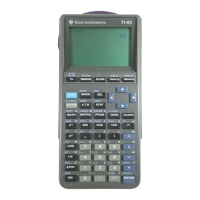3
G
RAPHING
T
ECHNOLOGY
G
UIDE
: TI-82
Copyright © Houghton Mifflin Company. All rights reserved.
Note that the TI-82 distinguishes between subtraction and the negative sign. If you wish to enter a negative number,
it is necessary to use the (-) key. For example, you would evaluate –5 – (4 · – 3) by pressing (-) 5 – ( 4 × (-) 3)
ENTER to get 7.
Enter these expressions to practice using your TI-82.
Expression Keystrokes Display
7 – 5·3
7 – 5 × 3 ENTER
–8
(7 – 5)·3
( 7 – 5 ) × 3 ENTER
6
120 – 10
2
120 – 10 x
2
ENTER
20
(120 – 10)
2
( 120 – 10 ) x
2
ENTER
12100
3
24
2
24 ÷ 2
∧
3 ENTER
3
3
24
2
( 24 ÷ 2 )
∧
3 ENTER
1728
(7 – –5)·–3
( 7 – (-) 5 × (-) 3 ENTER
–36
2.1.5 Algebraic Expressions and Memory: Your calculator can evaluate expressions such as
(1)
2
NN+
after you
have entered a value for N. Suppose you want N = 200. Press 200 STO➧ ALPHA N ENTER to store the value 200
in memory location N. Whenever you use N in an expression, the calculator will substitute the value 200 until you
make a change by storing another number in N. Next enter the expression
(1)
2
NN+
by typing ALPHA N (ALPHA
N + 1) ÷ 2 ENTER. For N = 200, you will find that
(1)
2
NN+
= 20100.
The contents of any memory location may be revealed by typing just its letter name and then ENTER. And the
TI-82 retains memorized values even when it is turned off, so long as its batteries are good.
2.1.6 Repeated Operations with ANS: The result of your last calculation is always stored in memory location ANS
and replaces any previous result. This makes it easy to use the answer from one computation in another
computation. For example, press 30 + 15 ENTER so that 45 is the last result displayed. Then press 2nd ANS ÷ 9
ENTER and get 5 because
45
9
= 5.
With a function like division, you press the ÷ key after you enter an argument. For such functions, whenever you
would start a new calculation with the previous answer followed by pressing the function key, you may press just
the function key. So instead of 2nd ANS ÷ 9 in the previous example, you could have pressed simply ÷ 9 to achieve
the same result. This technique also works for these functions: + – ×
∧
x
2
x
–1
.

